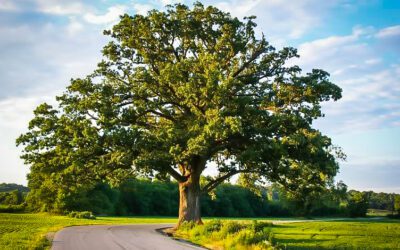Trees are plants, and as you know plants need nutrients, water, and sunlight to live, grow and thrive. But what happens to trees in the frigid cold of a Midwest winter? You can’t just pick up a tree and move it indoors (usually), so it must weather the cold and come out on the other side in springtime. The short answer is dormancy. But, what is dormancy, exactly? How does it work inside the tree?
During dormancy, a tree’s energy consumption, growth and metabolism all slow down significantly. A tree’s dormancy happens in stages, beginning in autumn with the loss of leaves. Broadleaf trees release a chemical called abscisic acid which signals the leaves to detach, keeping the tree from having to expend energy to keep the leaves alive through winter. Letting go of the tree’s leaves allows it to endure the long, cold months ahead. Evergreens have needles that have a much smaller surface area and a protective waxy coating, allowing these trees to maintain their foliage year-round.
Trees have bark. Bark acts as an insulating blanket for the tree by protecting it from freezing and cracking during the cold winter. Bark comes in a variety of different textures, densities and colors – all of which can help a tree survive cold temperatures by reflecting light and dispersing heat.
Trees begin to prepare themselves for winter in the autumn, as daylight hours decrease and temperatures begin to drop, and reach peak dormancy by mid-winter. The cells of a tree become glasslike in dormancy through a combination of cellular changes consisting of shrinkage, dehydration and sugar concentration. This helps prevent freezing and damage to living cells.
The growth of a tree is brought nearly to a halt in winter. The energy stored within the tree’s cells is used to maintain health rather than growth. Without growth, cell division, or the need to keep leaves alive, the tree can run on “essential systems” only, until spring.
While trees possess amazing abilities to mitigate the cold temperatures, there are times when it is just too much for a tree. This can happen for a variety of reasons, but the most dynamic of these is when there is a period of sudden, intense cold when trees haven’t yet had adequate time to go dormant or “harden off”. In these situations, the water inside the tree’s cells can freeze and quite literally explode. As the water inside the tree’s cells and sap freezes and expands rapidly, pressure builds inside the tree and bark acts as the housing for a ticking time bomb! If the expansion becomes so great that the bark can no longer hold the tree together, an explosion occurs in dramatic fashion. In the Midwest, these exploding tree events are fairly rare, thankfully.
It is always a good practice to have the health of your trees evaluated by a trained arborist, who can inform you of ways to help give your trees the best chances of survival. Consult with a professional arborist from Hentges Tree Service if you have any questions or concerns about tree health. Hentges Tree Service wants to help you keep your trees strong and healthy all year long!
DO YOU NEED HELP?
We’re here to serve you and we provide free estimates.



